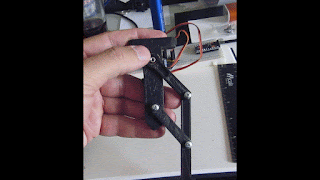Centipede!
I have always wanted to build a Centipede type robot. It would combine a walking and turning mechanism. And be able to scurry around through obstacles and dreams. Now that I am a self-styled robotist with a 3D printer, I can build one!
DESIGN
Basically, the robot needs to support its weight and payload, be able to move forward/backward, and then steer to the left/right. The target motive force is a single/duo of dc brushed motors, with connectors between the 'segments'. It needs to carry a camera, lights, speakers, for streaming. It needs controller, wifi, RPI(?), and battery / portable power.
Right now, I am satisfied with it "scurrying" about. But, getting those legs tangled in vertical things will be a future problem. I am not going to worry about that in the first prototypes.
The key to this design will be how to create the basic rotational motion of the leg to Lift-Place-Move each of the legs. First thoughts had a pair of rotational gears, one to lift the legs, the other to move forward-backward.
 |
| Initial thoughts for Leg Motion, placement, and mechanisms |
I created a couple of drafts on the cam/lifter/crankshaft thoughts. But, this seems to be overly complex. It needed simplicity.
Ball and Socket
The simplest thought would be to have a gear/cam spinning and moving a lever arm of the leg, that is suspended by a ball and socket arrangement. The most immediate concern would be the amount of friction in the ball/socket. This could be managed with some grease. future designs could even use metal or teflon to reduce the friction. To the CAD!
 |
| First draft of the ball/socket - OpenSCAD |
The plan is to 3D print a single full leg segment for testing and Prototyping. I am using a 'chopstick' for the leg.
 |
| First print for the prototype - Test, Adjust, and Print again! |
The first rough print yielded some immediate feedback. The socket will need to be wider to better contain the ball. but, sizing on ball for a chopstick style let was right. I was playing wth an old cam print for sizing, this will go next into the design. I am also thinking that having a modular/adjustable leg segment will be important. But, I do not want to get too far ahead in the design there are still a lot of moving variables.
Internet inspiration:
 |
| Festo BioFinWave |
here are some companies doing somethings with various linkages, but provide a 'fin' that can move on fluid surfaces:
It will be along way for me to go, compared to these systems.













































